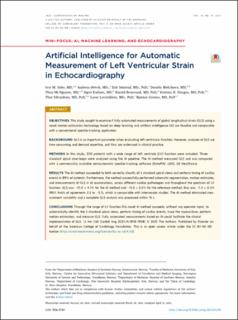| dc.contributor.author | Salte, Ivar M. | |
| dc.contributor.author | Østvik, Andreas | |
| dc.contributor.author | Smistad, Erik | |
| dc.contributor.author | Melichova, Daniela | |
| dc.contributor.author | Nguyen, Thuy Mi | |
| dc.contributor.author | Karlsen, Sigve | |
| dc.contributor.author | Brunvand, Harald | |
| dc.contributor.author | Haugaa, Kristina H. | |
| dc.contributor.author | Edvardsen, Thor | |
| dc.contributor.author | Løvstakken, Lasse | |
| dc.contributor.author | Grenne, Bjørnar | |
| dc.date.accessioned | 2022-03-04T09:02:04Z | |
| dc.date.available | 2022-03-04T09:02:04Z | |
| dc.date.created | 2021-06-19T09:59:47Z | |
| dc.date.issued | 2021 | |
| dc.identifier.citation | JACC Cardiovascular Imaging. 2021, 14 (10), 1918-1928. | en_US |
| dc.identifier.issn | 1936-878X | |
| dc.identifier.uri | https://hdl.handle.net/11250/2983009 | |
| dc.description.abstract | Objectives
This study sought to examine if fully automated measurements of global longitudinal strain (GLS) using a novel motion estimation technology based on deep learning and artificial intelligence (AI) are feasible and comparable with a conventional speckle-tracking application.
Background
GLS is an important parameter when evaluating left ventricular function. However, analyses of GLS are time consuming and demand expertise, and thus are underused in clinical practice.
Methods
In this study, 200 patients with a wide range of left ventricle (LV) function were included. Three standard apical cine-loops were analyzed using the AI pipeline. The AI method measured GLS and was compared with a commercially available semiautomatic speckle-tracking software (EchoPAC v202, GE Healthcare.
Results
The AI method succeeded to both correctly classify all 3 standard apical views and perform timing of cardiac events in 89% of patients. Furthermore, the method successfully performed automatic segmentation, motion estimates, and measurements of GLS in all examinations, across different cardiac pathologies and throughout the spectrum of LV function. GLS was −12.0 ± 4.1% for the AI method and −13.5 ± 5.3% for the reference method. Bias was −1.4 ± 0.3% (95% limits of agreement: 2.3 to −5.1), which is comparable with intervendor studies. The AI method eliminated measurement variability and a complete GLS analysis was processed within 15 s.
Conclusions
Through the range of LV function this novel AI method succeeds, without any operator input, to automatically identify the 3 standard apical views, perform timing of cardiac events, trace the myocardium, perform motion estimation, and measure GLS. Fully automated measurements based on AI could facilitate the clinical implementation of GLS. | en_US |
| dc.language.iso | eng | en_US |
| dc.publisher | Elsevier | en_US |
| dc.rights | Attribution-NonCommercial-NoDerivatives 4.0 Internasjonal | * |
| dc.rights.uri | http://creativecommons.org/licenses/by-nc-nd/4.0/deed.no | * |
| dc.title | Artificial Intelligence for Automatic Measurement of Left Ventricular Strain in Echocardiography | en_US |
| dc.type | Journal article | en_US |
| dc.type | Peer reviewed | en_US |
| dc.description.version | publishedVersion | en_US |
| dc.source.pagenumber | 1918-1928 | en_US |
| dc.source.volume | 14 | en_US |
| dc.source.journal | JACC Cardiovascular Imaging | en_US |
| dc.source.issue | 10 | en_US |
| dc.identifier.doi | 10.1016/j.jcmg.2021.04.018 | |
| dc.identifier.cristin | 1916912 | |
| dc.relation.project | Norges forskningsråd: 237887 | en_US |
| dc.relation.project | Helse Sør-Øst RHF: 2017207 | en_US |
| cristin.ispublished | true | |
| cristin.fulltext | original | |
| cristin.qualitycode | 2 | |

